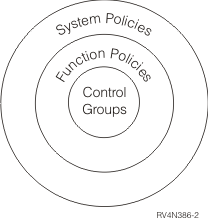
The media, move, backup, and recovery policies are sometimes called function policies because they pertain to specific, core BRMS functional activities. The system policy is called a global policy because BRMS applies many of its values to the core functional activities.
Figure 3 illustrates the hierarchical relationship between policies and control groups.

As you can see, the system policy is global and encompasses the function policies and the control groups. Unless otherwise altered, the information contained in system policy parameters overrides information that is contained in function policy parameters. By the same token, function policy information, unless otherwise altered, overrides control group information.
However, because save and restore needs vary depending on customer needs, policies and control groups that share the same parameters and values can override one another. In this way, a function policy value can override a shared system policy value, and a control group value can override a shared function or system policy value. The following examples illustrate override capability:
BRMS comes with several predefined values (called defaults) so that you can immediately begin carrying out your backup, recovery, and media management operations. You can change all or any of the default values at any time to better reflect the needs of your company. If you have modified the default values, you can reset these back to the default values by running the INZBRM OPTION(*DATA) command.
BRMS also comes with predefined backup control groups that allow you to perform an immediate and comprehensive backup of your entire system. You can find more information about the default backup control groups in Backing Up Your Entire System. You can find additional information about BRMS policies in Tailoring Your BRMS Operations.